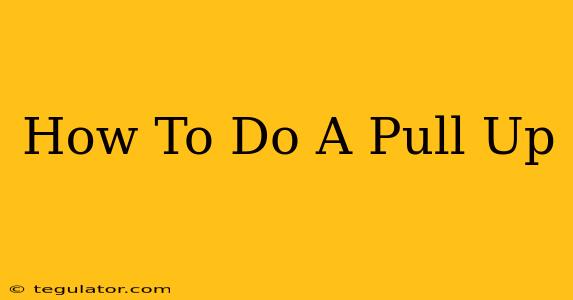The pull-up. A seemingly simple exercise, yet a hallmark of strength and fitness. For many, it represents a significant milestone on their fitness journey. But don't let its intimidating reputation deter you! This comprehensive guide breaks down how to do a pull-up, from beginner modifications to advanced progressions, ensuring you can conquer this challenging yet rewarding exercise.
Understanding the Pull-Up
Before we dive into the mechanics, it's crucial to understand what a pull-up is. It's a compound exercise, meaning it works multiple muscle groups simultaneously. Primarily, it targets your:
- Back Muscles: Latissimus dorsi (lats), rhomboids, trapezius (traps)
- Biceps: These play a significant supporting role.
- Forearms: Crucial for grip strength.
- Core: Essential for stability and maintaining proper form.
Mastering the pull-up isn't just about building strength; it's about developing overall body control and coordination.
Getting Started: Building the Foundation
For those who can't yet perform a full pull-up, don't despair! Begin with these foundational exercises to build the necessary strength and technique:
1. Negative Pull-Ups:
- How to: Jump or use a box to get into the top position of a pull-up. Slowly lower yourself down, focusing on controlled movement. Aim for 3 sets of 5-8 slow negatives.
- Why it works: This builds eccentric strength (the lowering phase), which is crucial for performing the full pull-up.
2. Assisted Pull-Ups:
- How to: Use an assisted pull-up machine (found in most gyms) or resistance bands to reduce the weight you need to lift. Adjust the assistance level as your strength improves.
- Why it works: Gradually reduces the load, making pull-ups more manageable.
3. Australian Pull-Ups (Inverted Rows):
- How to: Use a sturdy bar (e.g., a low bar in a gym, a sturdy table) and position yourself underneath, lying on your back with your body straight. Pull yourself up towards the bar, keeping your body in a straight line.
- Why it works: Excellent for building the strength needed for pull-ups, adaptable to different fitness levels.
4. Lat Pulldowns:
- How to: A weight machine exercise that mimics the movement of a pull-up.
- Why it works: Builds strength in the back muscles needed for pull-ups.
Mastering the Pull-Up Technique
Once you can perform assisted pull-ups with ease, it's time to tackle the full movement:
-
Grip: Grab the pull-up bar with an overhand grip, slightly wider than shoulder-width apart. Experiment with different grips (e.g., close grip, neutral grip) to find what suits you best.
-
Hang: Hang from the bar with your arms fully extended, keeping your body straight. Engage your core to prevent swaying.
-
Pull: Pull yourself up by squeezing your shoulder blades together and pulling your chest towards the bar. Keep your elbows close to your body.
-
Top Position: Your chin should clear the bar. Briefly pause at the top before lowering yourself slowly back down to the starting position.
-
Controlled Descent: This is just as important as the upward pull. Avoid dropping down; maintain control throughout the entire movement.
Progressing and Beyond
As you get stronger, aim to increase the number of repetitions you can perform. You can also add variations to challenge yourself, including:
- Weighted Pull-Ups: Increase the difficulty by adding weight to your body.
- Muscle-ups: A more advanced movement combining a pull-up and a dip.
Consistency is Key
Remember, mastering the pull-up takes time and dedication. Be patient, consistent, and celebrate your progress along the way. With consistent effort and the right techniques, you'll be performing pull-ups confidently in no time!

